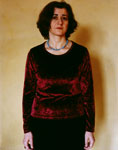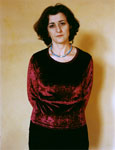
| Before the shooting I felt a certain irritation. When it came to the preparations for this event, the process of which I know, and the effects of which I can sense, there was an atmosphere of inner tension in the air. To place oneself in front of this magic box, in front of the object which has the power to "translate" you into a picture, into an image which is "objectivized" on a surface, always means something like a gift to me. Even if video, film and photography make use of the same devices in order to capture the light within the shooting mechanism, they operate in a very different way with respect to the problematic of time and that of the controlling of the picture. In the traditional photographic process there is always a certain time span between the mechanical snap shut which determines the shot, and the moment in which you are confronted with the result, with the picture then fixed onto the foil. To place myself in front of the lens after having been behind it for such a long time, to find myself on the other side of the barricade while being conscious of the materializing process of the picture which takes place within the machine, has produced a feeling of self-consciousness and, simultaneously, one of expectation: how would my two-dimensional substitute turn out? The 180° turn of the position, from an acting subject to the object of reproduction, has generated an intimate resistance inside me. Unlike video, the picture camera allows for no self-observation, so I couldn't control the picture as I used to; this made me feel somewhat disarmed. The use of the sheet camera in particular, without the flash reducing the time of exposing and that of posure, enhanced the awareness of the event. The immobility imposed on me before this glass eye forced me to find a point of balance, to enter my body, and to feel it from within. It was strange to perceive my own body from the inside and to feel how the most minimal movement of any muscle would cause the final picture to have a different balance of composition. To feel parts of my body from within, while they have put themselves into place in order to transform themselves in a picture by means of their chromatic reflection. The combination of clothes wasn't left up to chance, either; there was something special in this setting up of reality and of myself for being turned into a picture, and there was something special in this composing of oneself as an aesthetically meaningful form. The box before my eyes had something antiquated, like a toy or a measuring instrument from other times. The dark cloth on Tina's head made the machine become one with the woman's body, veiled in black. As if there was an amorphous, half-living being before my eyes, one which had something threatening and sensual. The woman-machine body was like a shadow in the back light of the familiar walls of my apartment. The mechanical box produced sounds that made me think of a chronometry, like relay mechanisms. How much light in how much time would one have needed in order to expose a sensitized sheet? The snap shut of the device which decided how a certain amount of light in a certain period of time would turn into a representation of myself, reminded me of the sound of the guillotine. The photograph is a cut in the current of becoming, and the photographic portrait is a "cross-section" of time, crystallizing, what would normally only be a change of forms within time, into another matter. The seeming coincidence of the picture and the temporary combination of matter, actions, thoughts and signs, which we call "I", is what serves, for a longer or shorter period of time, as a fundament of our being. Belief, identity, both our own and our knowing about that of others, would be impossible without the so-called objectivity of the image. Through the reification of the "I" into its own image one becomes information, a means of communication, and perceivable for others in one's absence as well. It is through representation that we can easily define an "I", of which not even the face could otherwise be seen, and distinguish it from the many "yous" which form part of one's own visual landscape. In the strange mechanism of our body the organ which is in charge of the function of seeing, is programmed in such a way that it can't see itself. If it weren't duplicated by some reflecting surface, the outside of our body would remain unknown to us. In every day life our body is not, for most of our actions, within the scope of our visibility, and we only have a deformed vision of hands, arms, chest, belly, legs and feet. From our face we only see some blurred contours of nose, mouth and cheek; the back of our head is unknown to us like the dark side of the moon. In some kind of duel or dialogue the mechanical toy swallowed slices of pictural compositions that were more remote in time; I produced them with my body and my look by means of my more or less conscious way of letting other segments of myself become transparent in the different takings. Every taking was the result of a confrontation, in which the filter of my consciousness decided, each time anew, for a different mixture of the different sides of my way of being, all of them covered by a layer of distance. The emotional state in my body changed according to the various combinations which consisted of the different plays of balance between showing and hiding myself. I already knew other portraits by Tina, those in the "Plot Point" series, and I was aware of the risk I was taking... When viewing the photographs from this project, I am amazed at the diversity of individuals depicted. At the same time, the women in this series seems to me to be trapped in their bodies, or perhaps they are instead trapped within the photographic frame. The images make an impression of concentration, yet nothing is dramatic... Everything seems to be frozen in time, while the "camera eye" is aimed at the centers of the bodies. The heads - normally the compositional focus in portraits, because they are ideally suited to the recognition of individuality and differences - play secondary roles in these photographs... They have been shifted to the upper parts of the images, where they press against the edges... In each, the body - nearly always truncated below the pubic bone by the lower edge of the picture - seems to want to indicate even more clearly the impossibility of movement, the rigidity of the pose, the cut in time. |
 |
 |
 |
 |
 |
 |
 |
 |



 project
project